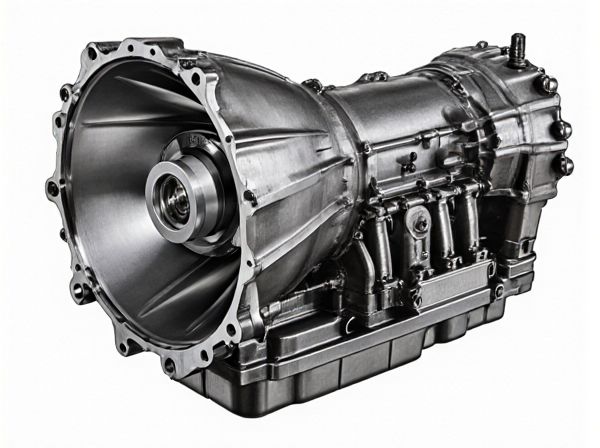
Photo illustration: Single Overdrive Transmission vs Multiple Overdrive Transmission
Single overdrive transmission offers one gear with a ratio lower than 1:1, optimizing fuel efficiency and reducing engine RPM during highway cruising. Multiple overdrive transmissions provide several gears with overdrive ratios, enhancing performance flexibility and smoother acceleration across various speeds. Your choice depends on driving habits, with single overdrive suited for steady highway driving and multiple overdrive ideal for versatility and improved fuel economy in varied conditions.
Table of Comparison
| Feature | Single Overdrive Transmission | Multiple Overdrive Transmission |
|---|---|---|
| Number of Overdrive Gears | One overdrive gear | Two or more overdrive gears |
| Fuel Efficiency | Moderate improvement at cruising speeds | Higher fuel efficiency due to better gear ratio optimization |
| Performance | Simpler design, adequate for most driving conditions | Enhanced performance with smoother acceleration |
| Complexity | Less complex, easier maintenance | More complex, potentially higher maintenance |
| Cost | Generally lower cost | Higher cost due to additional components |
| Application | Common in standard passenger vehicles | Preferred in performance and luxury vehicles |
Introduction: Understanding Overdrive Transmissions
Overdrive transmissions enhance fuel efficiency and reduce engine wear by enabling the engine to run at lower RPMs during high-speed driving. Single overdrive transmissions feature one gear ratio higher than the engine's cruising speed, while multiple overdrive transmissions incorporate several higher gear ratios to optimize performance across various driving conditions. Understanding the mechanics and benefits of single versus multiple overdrive transmissions is crucial for selecting the ideal system for specific vehicle applications.
What Is a Single Overdrive Transmission?
A single overdrive transmission features one gear ratio designed to reduce engine RPM at cruising speeds, improving fuel efficiency and reducing engine wear. This type of transmission is typically found in older vehicle models or simpler drivetrains, optimizing performance primarily for highway driving conditions. Single overdrive systems contrast with multiple overdrive transmissions, which offer several overdrive gears to provide a broader range of efficient cruising speeds and enhanced overall fuel economy.
Definition and Mechanics of Multiple Overdrive Transmissions
Multiple overdrive transmissions consist of gear systems featuring more than one gear ratio exceeding a 1:1 ratio, enabling lower engine RPMs at higher vehicle speeds to improve fuel efficiency and reduce engine wear. These transmissions utilize a combination of planetary gear sets or other gear assemblies to achieve multiple overdrive gears, providing flexible power delivery and optimized torque management for various driving conditions. Compared to single overdrive transmissions, multiple overdrive systems offer enhanced performance through smoother gear shifts and better adaptation to speed variability.
Performance Differences: Single vs. Multiple Overdrive
Single overdrive transmissions provide one gear ratio that reduces engine RPM at cruising speeds, enhancing fuel efficiency and reducing engine wear. Multiple overdrive transmissions offer several higher gear ratios, optimizing performance by allowing the engine to operate within its optimal power band across varying speeds and loads. This results in smoother acceleration, improved fuel economy, and greater versatility compared to single overdrive systems.
Fuel Efficiency Comparison
Single overdrive transmissions typically provide a single high gear ratio that reduces engine RPM at cruising speeds, improving fuel efficiency by lowering fuel consumption during highway driving. Multiple overdrive transmissions offer several higher gear ratios, allowing the engine to operate closer to its optimal efficiency across a broader range of speeds, resulting in enhanced fuel savings and smoother performance. Vehicles equipped with multiple overdrive gears often achieve better overall fuel economy compared to single overdrive setups due to improved adaptability to varying driving conditions.
Impact on Driving Experience
Single overdrive transmissions improve fuel efficiency and reduce engine wear by maintaining lower RPMs at cruising speeds, resulting in quieter cabin noise and smoother acceleration. Multiple overdrive transmissions offer more gear ratios, enhancing performance and adaptability across various driving conditions, leading to better responsiveness and optimized power delivery. Drivers experience increased comfort and control with multiple overdrive systems, especially during highway driving and towing scenarios.
Suitability for Various Vehicle Types
Single overdrive transmissions are ideal for vehicles that prioritize fuel efficiency and smooth highway cruising, such as compact cars and light-duty trucks. Multiple overdrive transmissions offer greater flexibility and performance across diverse driving conditions, making them suitable for SUVs, heavy-duty trucks, and performance vehicles that require a wider gear range. Selecting the appropriate overdrive type depends on the vehicle's intended use, load capacity, and desired balance between fuel economy and power delivery.
Maintenance and Longevity Considerations
Single overdrive transmissions typically require less complex maintenance due to fewer components, resulting in reduced service costs and simpler troubleshooting. Multiple overdrive transmissions, while offering better fuel efficiency and performance through varied gear ratios, may demand more frequent inspections and specialized servicing to ensure longevity. Choosing between the two depends on balancing maintenance frequency and the desired transmission lifespan under specific driving conditions.
Cost Implications: Initial and Long-Term
Single overdrive transmissions generally have lower initial costs due to simpler design and fewer components, making them more affordable upfront. Multiple overdrive transmissions, while pricier initially, offer improved fuel efficiency and reduced engine wear which can lead to significant long-term savings on fuel and maintenance. Evaluating cost implications must balance the higher upfront investment against potential extended vehicle lifespan and operational cost reductions.
Choosing the Right Overdrive Transmission for Your Needs
Single overdrive transmissions offer simplicity and improved fuel efficiency by providing one gear ratio above the standard drive, ideal for drivers seeking basic highway performance. Multiple overdrive transmissions feature several overdrive gears, enhancing fuel economy and engine longevity across various speeds, suitable for those who require versatile driving conditions or heavy towing capacity. Selecting the right overdrive transmission depends on factors such as vehicle use, fuel efficiency goals, and engine load to ensure optimal performance and durability.
 caratoz.com
caratoz.com